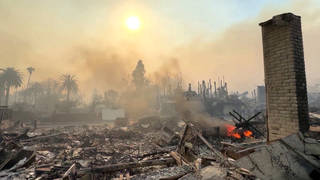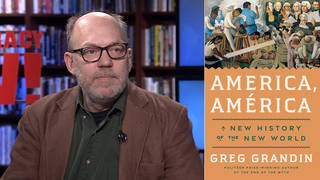
Guests
- Daniel Swainclimate scientist at UCLA and author of Weather West, a blog about California weather and climate science.
Links
In California, at least 19 people have died as storms continue to batter the region, leading to widespread flooding, mudslides and power outages. The National Weather Service says large portions of Central California have received over half their annual normal precipitation in just the past two weeks — and more rain is coming. The National Oceanic and Atmospheric Administration says 34 million Californians are under a flood watch. Despite the devastating impacts, few media outlets have drawn a connection between the historic weather and human-induced climate change. For more on the climate emergency, we are joined by Daniel Swain, climate scientist at UCLA, fellow at the National Center for Atmospheric Research and author of California weather blog Weather West.
Transcript
AMY GOODMAN: This is Democracy Now!, democracynow.org, The War and Peace Report. I’m Amy Goodman, with Nermeen Shaikh.
In California, at least 19 people have died as storms continue to batter the region, leading to widespread flooding, mudslides and power outages. Thousands of residents have been ordered to evacuate in some areas, including parts of Santa Barbara and Monterey County. Five million people in California remain under a flood watch. The National Weather Service says large portions of Central California have received over half their annual normal precipitation in just the past two weeks — and more rain is coming. Santa Cruz County Supervisor Zach Friend has described the storms as a, quote, “once-in-a-generational challenging event.”
In San Miguel, California, the National Guard has joined in the effort to find a 5-year-old boy named Kyle Doan, who was swept away by the floodwaters Monday.
Meteorologists say California is being hit with what’s known as an atmospheric river of rain, which has unleashed unrelenting storms.
Meanwhile, Media Matters reports national TV news is largely ignoring the link between climate change and the deluge devastating California. The group looked at 60 segments that aired on national TV news networks between December 31st and January 4th. Only one mentioned climate change.
To talk more about the storms in California, we’re joined by Daniel Swain, climate scientist at UCLA, author of Weather West, the California weather blog. He’s also a research fellow at the National Center for Atmospheric Research and at The Nature Conservancy.
Daniel, welcome back to Democracy Now! OK, can you talk about what’s happening in California right now and how it links to climate change?
DANIEL SWAIN: Thanks for having me.
Well, as you mentioned in the introduction, California has been experiencing now a multiweek period of very heavy precipitation, really from a sequence of strong storm events, some of which have been what are known as atmospheric rivers, which are these corridors of highly concentrated atmospheric water vapor moving quickly through the atmosphere. So, California hasn’t been experiencing an atmospheric river continuously for multiple weeks, but the net result of multiple storms over the past several weeks has been to produce pretty significant flood impacts in certain parts of California that have, unfortunately, as you mentioned, turned deadly.
NERMEEN SHAIKH: And so, Daniel Swain, could you talk about the way in which these storms, these extreme weather events, are being interpreted, and how it’s possible to look at them without looking at human-induced climate change?
DANIEL SWAIN: Yes, I think what’s clear from a climate science perspective at this point is that all weather events are evolving in the context of a changed climate. That is just the reality of the world we live in today. The question is, really, to what extent is climate change influencing certain kinds of events, not really whether it is in the first place. It’s really a question of how much.
And in this case, we know that the primary link between climate change and extreme precipitation events is through a fairly basic fundamental principle of atmospheric thermodynamics. That sounds complicated, but it really just comes down to the fact that the atmosphere has a much higher capacity to hold water vapor when it’s warmer. In fact, the increase in the water vapor-holding capacity of the atmosphere is exponential, even for a linear or an incremental warming.
So this is a pretty profound effect, because it raises, effectively, the ceiling on how intense precipitation can become by about 4% per degree Fahrenheit, or 7% per degree centigrade, of global warming. And so, today we’re at about 1.2 degrees or so centigrade of global warming. We’re at the point where perhaps 10 to 15% of the intensity at any given extreme precipitation event, on average, can probably be attributed to global warming. And, of course, that number is going to vary from event to event and region to region. But as a ballpark estimate, that 10 to 15% increase in the magnitude of extreme precipitation events could have really large effects already.
NERMEEN SHAIKH: And could you explain — one of the things that seems surprising about what’s happening in California is that, of course, this is a state that has suffered from massive drought over the last several years. So, how do these things go together — on one hand, drought, on the other hand, this extraordinary level of rain?
DANIEL SWAIN: Well, there is, first of all, a bit of a silver lining here, which is that, of course, with all of this rain, the severity of the California drought is decreasing with each passing week. Of course, in the long run, they don’t just simply counterbalance each other, the extreme dry and moving immediately to extreme wet. There are lots of reasons why it’s not an equal and opposite response.
But in this part of the world, there’s actually an expectation that climate change will bring about an increase in what I like to term hydroclimate or precipitation whiplash, if you will, this notion that the variability from season to season and year to year of precipitation in California is already high at background, but it is getting higher in a warming climate. So, in other words, we’re seeing even greater swings between extremely wet and extremely dry conditions, and vice versa, in this part of the world.
And our own work suggests that human-caused climate change is amplifying that effect. And that’s really leading to some significant management challenges, because, as you might imagine, the ways of coping with extremes on both ends of the spectrum are different than if you were just perennially getting drier or wetter. If you have both to deal with, it’s definitely more complicated.
AMY GOODMAN: So, Daniel Swain, what do you expect California’s weather to look like in the future? And is it a harbinger for the rest of the country?
DANIEL SWAIN: Well, California certainly has a climate that is distinct from the rest of the United States. It has what’s known as a Mediterranean climate, which, as you might expect, is similar to the climate of the Mediterranean itself and other similar zones around the world. So what’s happening there is a little bit different than what we might expect to see elsewhere.
But I think there are some generalities that we can reasonably assume, which is that, of course, it’s getting warmer. Temperatures themselves are rising. We’re seeing, on average, freezing levels during winter that are creeping up the mountainsides, although this winter has brought a fairly exceptional snowpack. So we’ve seen an extreme snowfall event this winter. So, things are getting warmer there, and we’re seeing both more extreme precipitation events, on the one hand, which is essentially happening everywhere, but also more severe droughts, on the other hand. And that’s not necessarily happening everywhere, but it is happening in many places.
And so, I think the things that people are surprised are happening in California, the increase in extreme precipitation events, that’s something that’s perhaps less surprising in other places, because we’ve seen even larger increases. So, we think about the eastern half of the United States, for example, and the increases in extreme rainfall events and flash flood events over the past few decades has been considerably more dramatic.
So, even though California is a place more recently accustomed to drought and water scarcity and wildfire, all of which are also increasing in California in a warming climate — don’t get me wrong — it’s a place that also needs to be dealing with the opposite extreme, that of extreme precipitation and the potential for an increase in the risk of severe flooding. And, in fact, our own work published in summer of 2022 suggests that climate change has already doubled the risk of a widespread severe flood event in California. And I think that comes much as a surprise to folks who are more accustomed to dealing with the opposite problem in recent years.
NERMEEN SHAIKH: And finally, Daniel, if you could talk about what you’re anticipating just in the next days in California?
DANIEL SWAIN: So, in the short term, we are expecting that, at least for the next five to seven days, this very active and rainy pattern will continue, so there will likely be some amount of further flooding with another strong storm due in on Saturday. There is some relief on the horizon, about eight or nine days out. It looks like the pattern will relent, and things will dry out. And that will give California a much-needed chance to — for rivers to recede and for folks in the mountains to dig out of snowbanks. But there may yet be some additional flooding and some additional landslides and things like that over the next week. So, it may get a little worse before it get better, but there hopefully is an end in sight.
AMY GOODMAN: Daniel Swain, we want to thank you so much for being with us, climate scientist at UCLA, author of Weather West, the California weather blog. He’s also a research fellow at NCAR. That’s the National Center for Atmospheric Research, where he is right now, in Boulder, Colorado. In fact, NCAR is a renowned climate research center that was almost burned to the ground by a climate-fueled wildfire.
That does it for our show. Democracy Now! is produced with Renée Feltz, Mike Burke, Deena Guzder, Messiah Rhodes, María Taracena, Tami Woronoff, Charina Nadura, Sam Alcoff, Tey-Marie Astudillo, John Hamilton, Robby Karran, Hany Massoud and Mary Conlon. Our executive director is Julie Crosby. Special thanks to Becca Staley, Jon Randolph, Paul Powell, Mike Di Filippo, Miguel Nogueira, Hugh Gran, Denis Moynihan, David Prude and Dennis McCormick.
To see other climate stories that Democracy Now! has focused on and our coverage of the U.N. climate summit recently in Egypt, go to democracynow.org. Tomorrow, we will look at the new film Argentina, 1985. I’m Amy Goodman, with Nermeen Shaikh.














Media Options